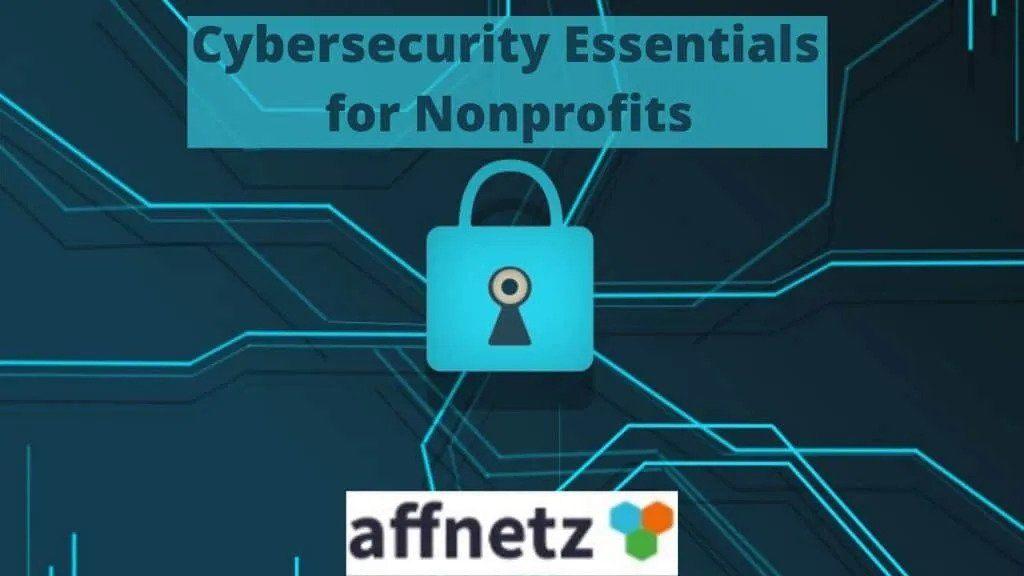Nonprofit Cybersecurity Complete Guide | Protect Your Data / By Bala Guntipalli
Introduction:
In today’s digital landscape, Nonprofit cybersecurity has become an increasingly pressing issue. Nonprofits often handle sensitive personal data, making them prime targets for cyber threats.
Breaches not only compromise individuals’ privacy but also expose nonprofits to legal ramifications. Recognizing the gravity of these risks, nonprofits must proactively implement measures to safeguard their data and operations.
Understanding the Risks
Nonprofits need to assess their vulnerability to cyberattacks across various dimensions:
First Step | Risk Assessment
Identify and assess potential cybersecurity risks, including risks to data confidentiality, integrity, and availability.
Evaluate vulnerabilities, threats, and potential impacts on data.
Consider data classification and sensitivity to prioritize data protection efforts.
Security Policies and Procedures:
Develop comprehensive cybersecurity policies and procedures that include data protection measures.
Address data encryption, access controls, data handling procedures, and secure data storage and transmission
Employee Training and Awareness:
Train employees on data protection best practices, emphasizing the importance of data confidentiality and privacy.
Educate them on data handling procedures, secure file sharing, and recognizing and reporting data breaches or incidents.
Incident Response Plan:
Develop an incident response plan that includes specific steps for handling data breaches or data security incidents.
Define roles and responsibilities for handling and reporting data-related incidents.
Establish communication channels for reporting and escalating data incidents.
Second Step | Data Protection
The action step is where organizations take concrete steps to protect their data, including securing networks, implementing access controls, employing encryption, utilizing data loss prevention measures, assessing third-party cybersecurity practices, and applying regular security updates.
Secure Network Infrastructure:
Implement encryption mechanisms, such as secure socket layer (SSL) or transport layer security (TLS), for protecting data in transit.
Employ firewalls, intrusion detection systems, and other security measures to safeguard data stored on networks and systems.
Access Controls:
Implement strong access controls, including multi-factor authentication and role-based access controls, to ensure authorized access to sensitive data.
Regularly review and update user access privileges based on job roles and responsibilities.
Data Protection:
Employ encryption mechanisms, such as full disk encryption or database encryption, to protect sensitive data at rest.
Implement data loss prevention (DLP) controls to prevent unauthorized data exfiltration or accidental data leaks.
Vendor Risk Management:
Assess the cybersecurity practices of third-party vendors or service providers, paying particular attention to how they handle and protect data.
Establish strong contractual agreements that outline data protection requirements for vendors or service providers.
Patch and Vulnerability Management:
Regularly apply security patches and updates to software, firmware, and systems to address known vulnerabilities that could impact data security.
Third Step | Risk Identification
The response step requires organizations to promptly address data breaches or incidents. It involves detecting and analyzing the incident’s impact on data, implementing containment measures, communicating with stakeholders, conducting forensic investigations, and restoring systems. This phase aims to mitigate the impact of the incident and improve data protection measures.
Incident Detection and Analysis:
Monitor for data breaches or unauthorized access to sensitive data.
Analyze incidents to determine the extent and impact on data and initiate immediate response actions.
Incident Containment and Mitigation:
Isolate affected systems or networks to prevent further unauthorized access or data compromise.
Take immediate actions to mitigate the impact on data, such as revoking compromised credentials or disabling compromised accounts.
Communication and Reporting:
Notify appropriate stakeholders, including internal teams, data subjects, regulatory bodies, and law enforcement, as required by data protection regulations.
Comply with legal and regulatory reporting obligations for data breaches or incidents involving sensitive data.
Forensic Investigation:
Conduct a forensic investigation to determine the root cause of the data breach or incident.
Identify compromised data and systems, collect evidence, and establish a chain of custody for potential legal actions.
Incident Recovery and Lessons Learned:
Restore systems and data from backups to resume normal operations.
Conduct a post-incident analysis to identify areas for improvement in data protection measures and update security measures and policies accordingly.
Preparing for Cyber Attacks
Preparation is key to effectively mitigate the impact of cyberattacks on nonprofit organizations. By implementing proactive strategies, nonprofits can strengthen their cybersecurity posture and minimize the disruption caused by potential security breaches. Nonprofit cybersecurity incidents underscore the importance of investing in robust defense mechanisms and incident response plans.
Document Protocols
Establishing comprehensive cybersecurity policies and response protocols is crucial for nonprofit organizations. These protocols should outline clear procedures for detecting, responding to, and recovering from cyber incidents.
By documenting protocols in advance, nonprofits can ensure that staff members understand their roles and responsibilities in the event of a security breach. Moreover, having predefined protocols facilitates swift and coordinated action, enabling organizations to contain the breach and mitigate its impact on operations and data integrity.
Train Users
Cybersecurity for Nonprofits is incomplete without staff training. Nonprofits must prioritize ongoing cybersecurity training for all staff members to cultivate a culture of security awareness and best practices. Training programs should cover topics such as recognizing phishing attempts, creating strong passwords, and identifying suspicious activities. Nonprofit cybersecurity training empowers staff members to recognize and mitigate potential cyber threats effectively.
By empowering employees with the knowledge and skills to identify and mitigate cyber threats, nonprofits can significantly reduce the likelihood of successful attacks stemming from human error. Additionally, regular training sessions help reinforce cybersecurity protocols and keep staff members abreast of emerging threats and evolving best practices in the field.
Best Practices
Make Systems Redundant
Maintaining redundant systems and implementing robust data backup mechanisms are essential components of cybersecurity preparedness for nonprofits. Redundancy ensures that critical data and systems have backup copies stored in secure locations, thereby minimizing the risk of data loss or corruption in the event of a cyberattack.
By regularly backing up data and system configurations, nonprofits can expedite recovery efforts and restore operations with minimal downtime. Moreover, implementing automated backup solutions streamlines the backup process and ensures consistency and reliability in data protection practices.
Harden Systems
In addition to redundancy, nonprofits should take proactive measures to harden their IT systems against cyber threats. This involves implementing security controls and measures to mitigate vulnerabilities and strengthen the resilience of organizational infrastructure.
Examples of such measures include deploying antivirus software, intrusion detection systems, and firewalls to monitor and block malicious activities. Furthermore, enforcing multi-factor authentication across all accounts adds an extra layer of security by requiring users to provide multiple forms of verification before accessing sensitive data or systems.
By hardening their systems, nonprofits can reduce the likelihood of successful cyberattacks and enhance their overall cybersecurity posture.
Regular Testing and Review
Continuous testing and review of cybersecurity measures are essential for nonprofits to stay ahead of evolving threats and vulnerabilities. Conducting regular penetration testing and vulnerability assessments helps identify potential weaknesses in the organization’s IT infrastructure and applications.
Additionally, reviewing incident response plans and conducting tabletop exercises enables nonprofits to evaluate the effectiveness of their protocols and identify areas for improvement. By incorporating feedback from testing and review processes, nonprofits can refine their cybersecurity strategies and enhance their readiness to respond to cyber threats effectively.
Nonprofit Cybersecurity Tips to Keep Data Safe
Nonprofit cybersecurity requires constant vigilance and ongoing training to stay ahead of evolving cyber threats. In addition to the aforementioned strategies, nonprofits should adhere to best practices to uphold data security standards:
- Regularly update cybersecurity policies and protocols to address emerging threats and regulatory requirements.
- Conduct periodic risk assessments to identify and remediate vulnerabilities in the organization’s cybersecurity posture.
- Foster a culture of cybersecurity awareness and accountability among staff through ongoing training and communication initiatives.
- Engage with cybersecurity experts or consultants to leverage their expertise and stay abreast of evolving threats and best practices in the field.
Conclusion:
In an increasingly digital landscape, cybersecurity holds immense importance for nonprofits entrusted with sensitive data and the trust of stakeholders. By taking proactive steps to assess risks, implement protective measures, and foster a culture of security awareness, nonprofits can effectively mitigate the likelihood and impact of cyber incidents.
Key steps involve conducting comprehensive risk assessments to identify vulnerabilities, evaluating threats, and understanding data security impacts. Implementing protective measures includes deploying robust technical controls like firewalls, encryption, and access controls. Equally important is nurturing a culture of security awareness through training programs, campaigns, and policies.
By prioritizing cybersecurity, nonprofits demonstrate their commitment to data privacy, integrity, and mission-driven success. This approach builds trust among stakeholders and enhances the organization’s resilience and reputation. The synergy between cybersecurity and data protection empowers nonprofits to navigate the digital realm confidently, ensuring the security of sensitive information and upholding their responsibilities to those they serve.
Disclaimer: The content provided is for informational purposes only and does not constitute a binding recommendation. All trademarks, service marks, and logos appearing in the review are the property of their respective owners. Information may have changed since the publication date, and we encourage readers to verify the current accuracy of any data or claims.
Author
Bala has a wide variety of experience both in business, member-based associations and Nonprofits. With hundreds of successful projects to his credit, Bala’s business background includes positions at IBM Corporation, see more




